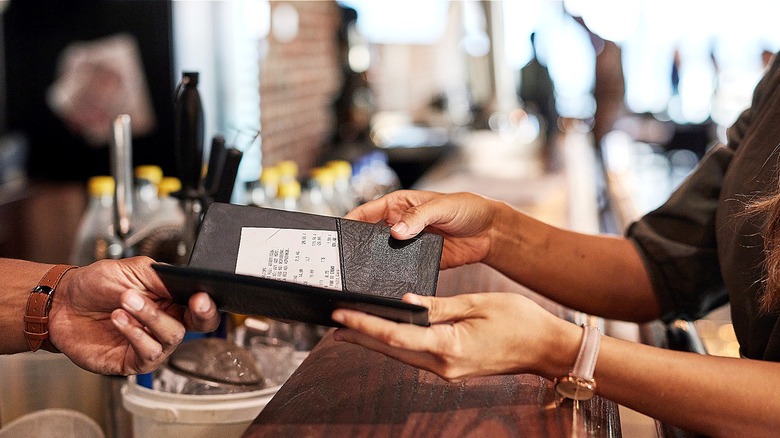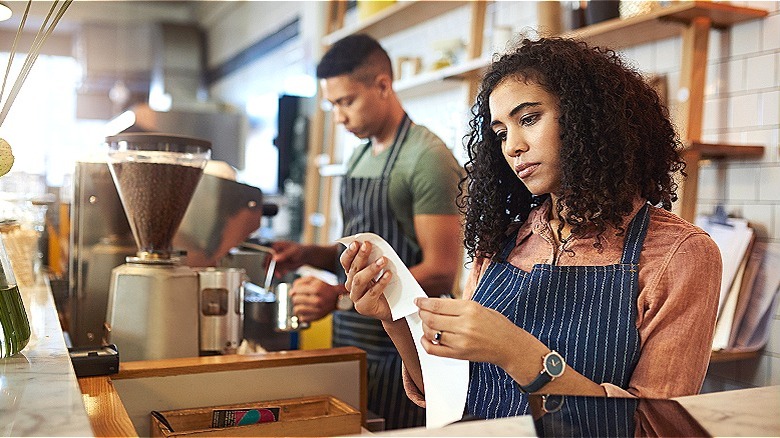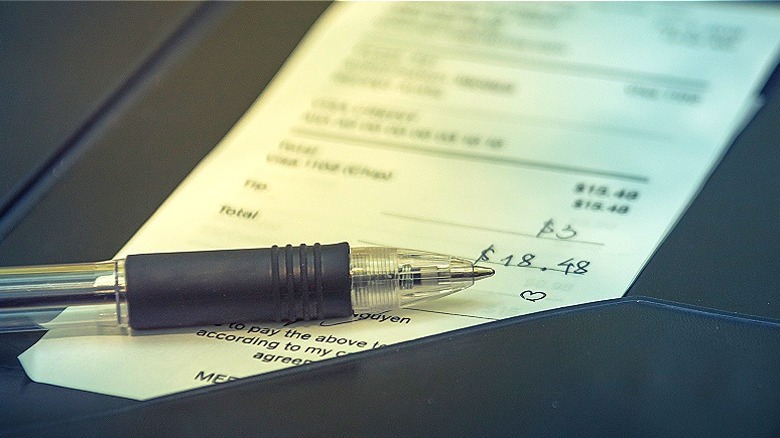Why You Always Need To Double-Check Your Receipt Before Leaving A Restaurant
Dining out can be a fun way to not only break up your week but also save you from some extra dishes. In fact, according to a 2023 US Foods survey, the average person dines out three times a month (and spends $166 a person per month to do so). In the survey, 75% of respondents reported that a primary motivation for dining out was because they didn't feel like cooking, while 51% of respondents also reported convenience as an important factor. With that said, perhaps one of the biggest elements of dining out that people are increasingly not crazy about is tipping.
While mandatory service fees have spread across many restaurants throughout the country, leaving diners confused about what and how to tip, most restaurants still rely on diners to tip their service staff. Servers, bartenders, hosts, and bussers oftentimes rely on tips for their income, and while they might only feel like an additional financial burden to your dining experience, they are ultimately an integral part of your meal.
Regardless of your preferred tipping amount, any tip can and does financially benefit restaurant workers (who, in addition to not having benefits or paid time off, also often face sub-minimum wage rates). This is why you should always double-check your receipt before leaving a restaurant, as probably one of the biggest errors you can make a diner is to take the only signed copy of your receipt with you when you leave.
Why is the signed receipt so important?
We get it: Between the itemized receipt, merchant copy, and customer copy, it can be exceptionally easy to mix up the various pieces of paper that can make up a restaurant check. With that being said, not double-checking and shoving the wrong receipt in your pocket can negatively impact the server who assisted you with your meal. By failing to leave a signed receipt with your preferred tip amount, restaurants are often unable to issue any tip amount to your server regardless of how large your bill may have been. This can be financially detrimental to servers and bartenders who might rely on tips for income.
This issue is even more complicated when you realize how tipped wages work in the majority of states in America. As Sylvia Allegretto, labor economist and co-chair of the Center on Wage and Employment Dynamics at the University of California, Berkeley, explained to Newsweek, "We have a two-tiered wage system in the U.S.: the federal minimum wage and the sub-minimum wage for tipped workers." There are currently 16 states that use the federal tipped minimum wage ($2.13 an hour) for tipped restaurant staff. This means that servers are only guaranteed this small hourly rate with the idea being that their tips will make up for the rest of their income. Twenty-six other states technically have a higher hourly rate than the $2.13 federal tipped rate, but they still fall below the standard federal minimum wage of $7.25.
What else to know about restaurant tipping
For anyone wondering, accidentally signing a customer copy receipt instead of the merchant copy isn't a deal breaker. The main thing to remember is that the restaurant needs to receive your signature in order to verify your selected tip amount. Even if you fill out the tip and total amounts, without a signature, your server would end up without a tip. So even if you end up signing the "wrong" receipt it'll still be accepted by most restaurants. The important thing is to double-check which receipt you leave with.
With that said, the confusion around tip amounts, signatures, and varying receipts is what ultimately led to the birth of the (very polarizing) touchscreen tip function on many point-of-sale machines used today. These touchscreen tip functions eliminate the need for printed receipts as well as pen-to-paper signatures, but they have been known to make customers feel more pressured about tips.
While tipping is increasingly becoming a contentious topic in the United States, it's important to realize that even though almost half of all purchases at fast food restaurants and coffee shops in 2022 included a tip (up 11% from the first quarter of 2020, per Toast data), overall tipping amounts in the country are down. According to Toast's Q2 2023 Restaurant Trends Report, full-service restaurant tips dipped to 19.4% on average. This represents the lowest average tip amount for restaurant servers since the beginning of the pandemic. While inflation and tipping fatigue can absolutely be factors when deciding when and how much to tip, make sure you factor in your state's tipped wage laws when it comes to your tipping practices.


